Abstract
This study was undertaken to determine the genetic control of host susceptibility to coxsackievirus B3 (CVB3)-induced chronic myocarditis in a mouse model. An autosomal recessive autoimmune myocardial disease (amd) gene (possibly more than one gene), which determined susceptibility to CVB3-induced chronic myocarditis in the A/J and DBA/2J inbred mouse strains, was mapped to a segment of chromosome 14. Data from both the AXB/BXA recombinant inbred (RI) strains and the B10.D2(57N) H-8b congenic mice supported this linkage relationship. Analysis of the AXB/BXA RI strain distribution patterns suggested that amd maps distal to the Np-2, Tcr alpha, and Myhc alpha loci.
Full text
PDF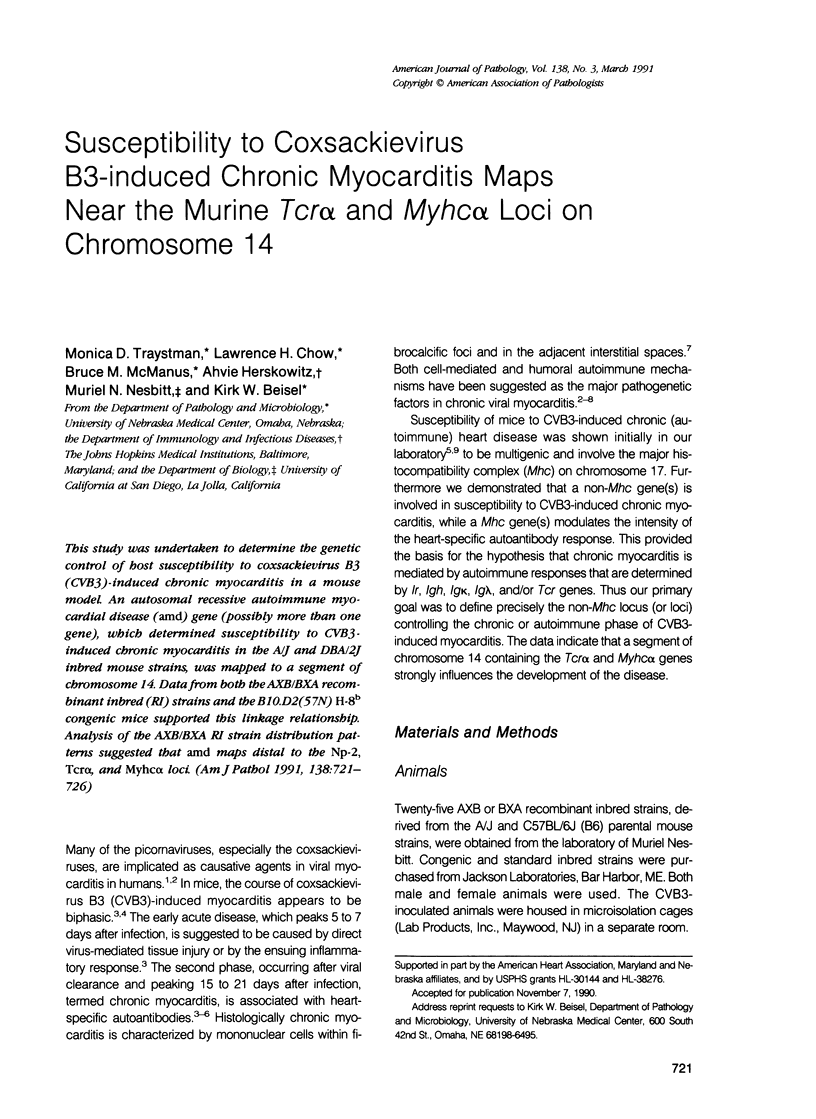
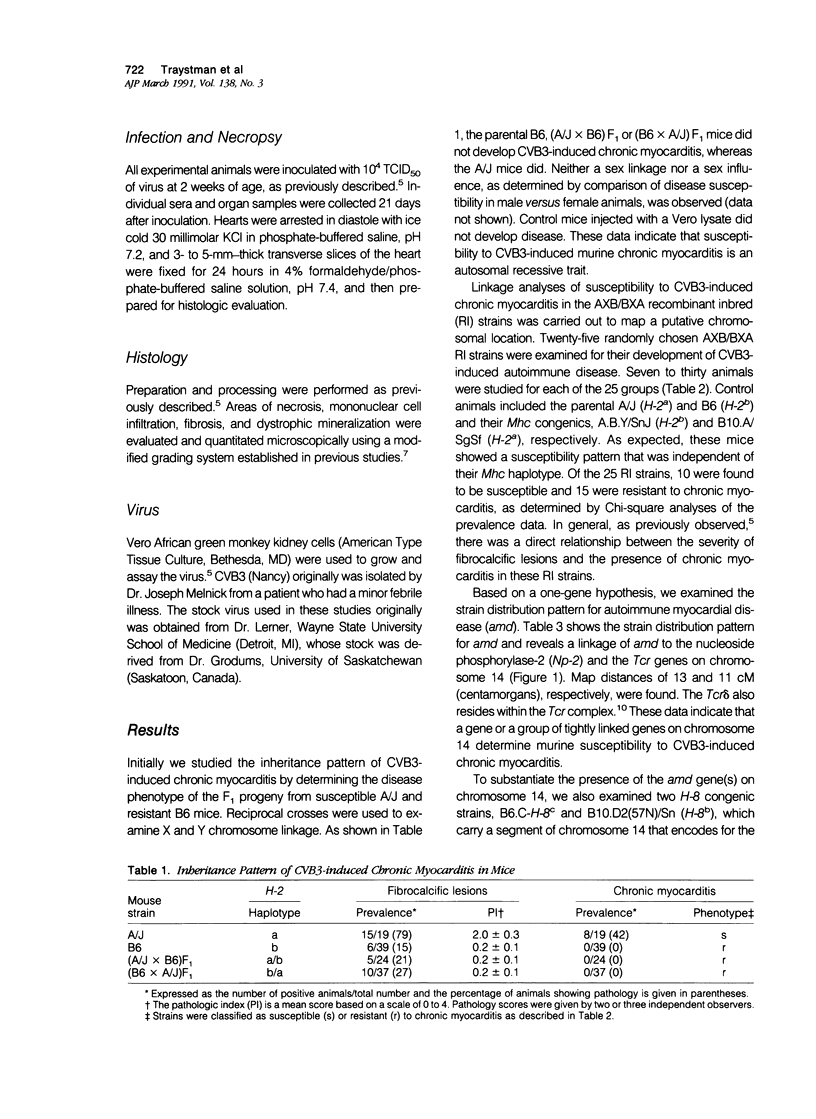
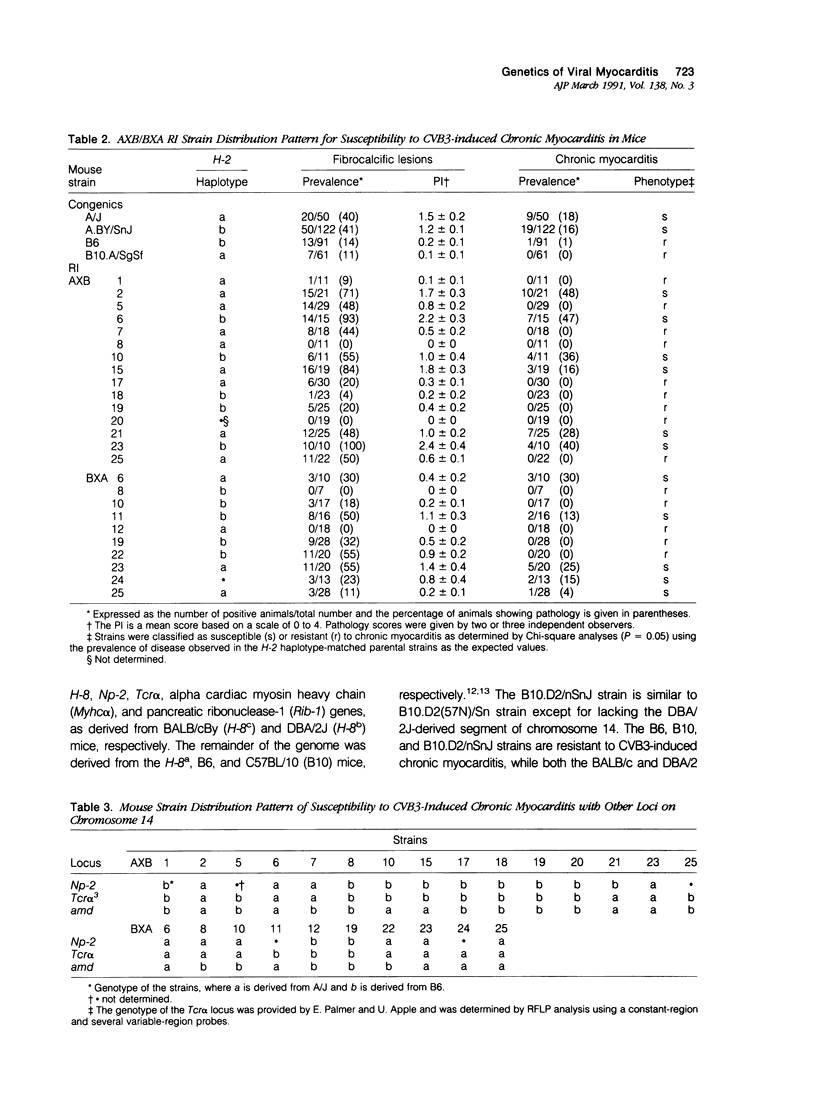
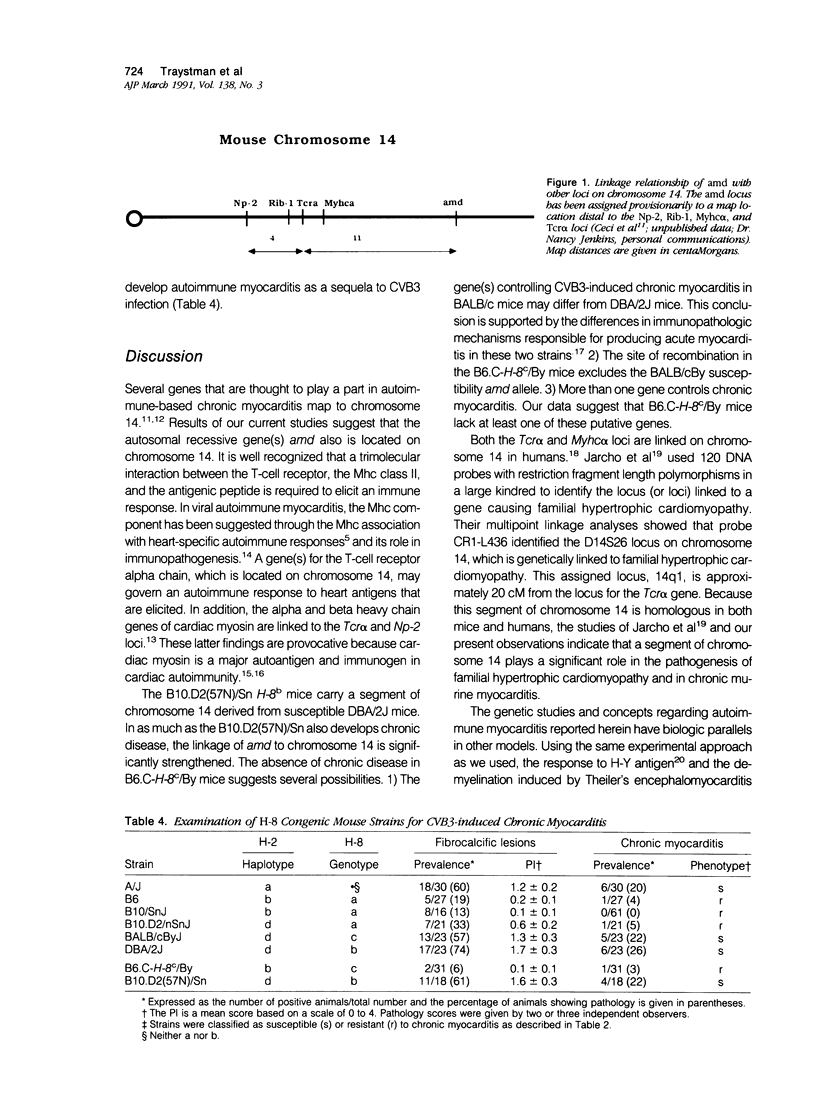
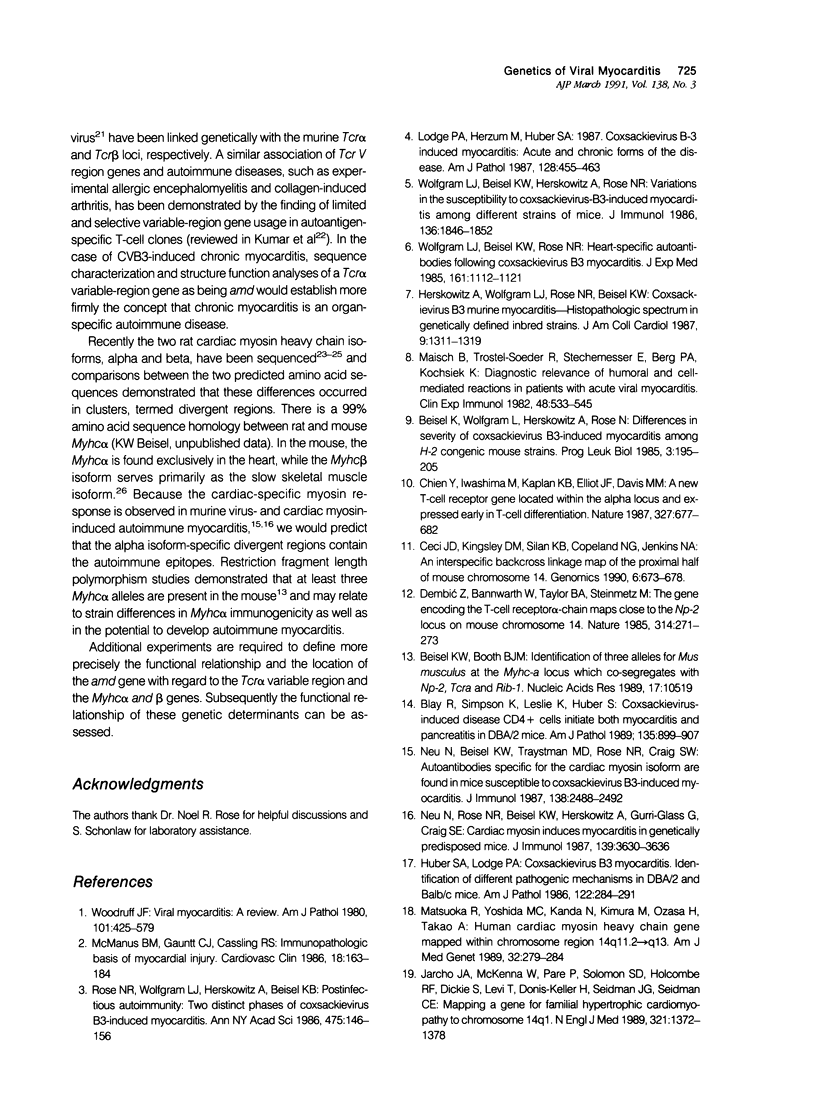
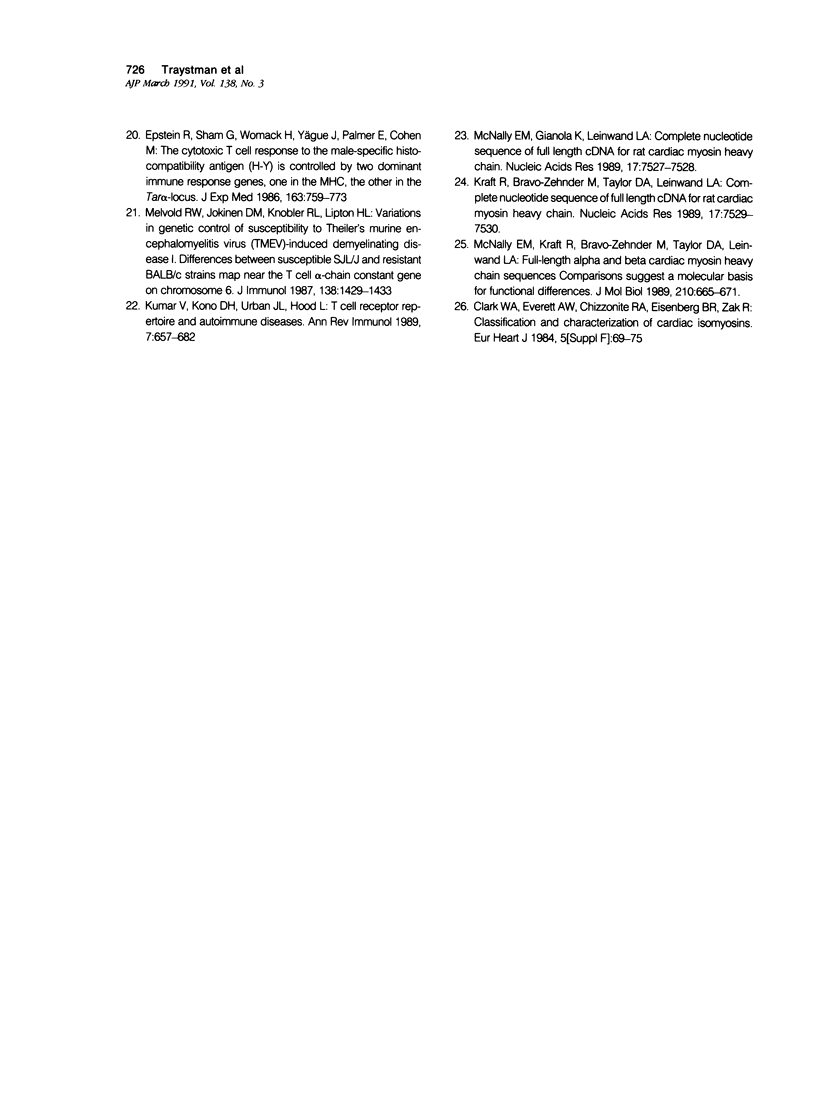
Selected References
These references are in PubMed. This may not be the complete list of references from this article.
- Beisel K. W., Booth B. J. Identification of three alleles for Mus musculus at the Myhc-a locus which co-segregates with Np-2, Tcra and Rib-1 on chromosome 14. Nucleic Acids Res. 1989 Dec 25;17(24):10519–10519. doi: 10.1093/nar/17.24.10519. [DOI] [PMC free article] [PubMed] [Google Scholar]
- Blay R., Simpson K., Leslie K., Huber S. Coxsackievirus-induced disease. CD4+ cells initiate both myocarditis and pancreatitis in DBA/2 mice. Am J Pathol. 1989 Nov;135(5):899–907. [PMC free article] [PubMed] [Google Scholar]
- Ceci J. D., Kingsley D. M., Silan C. M., Copeland N. G., Jenkins N. A. An interspecific backcross linkage map of the proximal half of mouse chromosome 14. Genomics. 1990 Apr;6(4):673–678. doi: 10.1016/0888-7543(90)90503-m. [DOI] [PubMed] [Google Scholar]
- Chien Y. H., Iwashima M., Kaplan K. B., Elliott J. F., Davis M. M. A new T-cell receptor gene located within the alpha locus and expressed early in T-cell differentiation. 1987 Jun 25-Jul 1Nature. 327(6124):677–682. doi: 10.1038/327677a0. [DOI] [PubMed] [Google Scholar]
- Clark W. A., Everett A. W., Chizzonite R. A., Eisenberg B. R., Zak R. Classification and characterization of cardiac isomyosins. Eur Heart J. 1984 Dec;5 (Suppl F):69–75. doi: 10.1093/eurheartj/5.suppl_f.69. [DOI] [PubMed] [Google Scholar]
- Dembić Z., Bannwarth W., Taylor B. A., Steinmetz M. The gene encoding the T-cell receptor alpha-chain maps close to the Np-2 locus on mouse chromosome 14. Nature. 1985 Mar 21;314(6008):271–273. doi: 10.1038/314271a0. [DOI] [PubMed] [Google Scholar]
- Epstein R., Sham G., Womack J., Yagüe J., Palmer E., Cohn M. The cytotoxic T cell response to the male-specific histocompatibility antigen (H-Y) is controlled by two dominant immune response genes, one in the MHC, the other in the Tar alpha-locus. J Exp Med. 1986 Apr 1;163(4):759–773. doi: 10.1084/jem.163.4.759. [DOI] [PMC free article] [PubMed] [Google Scholar]
- Herskowitz A., Wolfgram L. J., Rose N. R., Beisel K. W. Coxsackievirus B3 murine myocarditis: a pathologic spectrum of myocarditis in genetically defined inbred strains. J Am Coll Cardiol. 1987 Jun;9(6):1311–1319. doi: 10.1016/s0735-1097(87)80471-0. [DOI] [PubMed] [Google Scholar]
- Huber S. A., Lodge P. A. Coxsackievirus B-3 myocarditis. Identification of different pathogenic mechanisms in DBA/2 and Balb/c mice. Am J Pathol. 1986 Feb;122(2):284–291. [PMC free article] [PubMed] [Google Scholar]
- Jarcho J. A., McKenna W., Pare J. A., Solomon S. D., Holcombe R. F., Dickie S., Levi T., Donis-Keller H., Seidman J. G., Seidman C. E. Mapping a gene for familial hypertrophic cardiomyopathy to chromosome 14q1. N Engl J Med. 1989 Nov 16;321(20):1372–1378. doi: 10.1056/NEJM198911163212005. [DOI] [PubMed] [Google Scholar]
- Kraft R., Bravo-Zehnder M., Taylor D. A., Leinwand L. A. Complete nucleotide sequence of full length cDNA for rat beta cardiac myosin heavy chain. Nucleic Acids Res. 1989 Sep 25;17(18):7529–7530. doi: 10.1093/nar/17.18.7529. [DOI] [PMC free article] [PubMed] [Google Scholar]
- Kumar V., Kono D. H., Urban J. L., Hood L. The T-cell receptor repertoire and autoimmune diseases. Annu Rev Immunol. 1989;7:657–682. doi: 10.1146/annurev.iy.07.040189.003301. [DOI] [PubMed] [Google Scholar]
- Lodge P. A., Herzum M., Olszewski J., Huber S. A. Coxsackievirus B-3 myocarditis. Acute and chronic forms of the disease caused by different immunopathogenic mechanisms. Am J Pathol. 1987 Sep;128(3):455–463. [PMC free article] [PubMed] [Google Scholar]
- Maisch B., Trostel-Soeder R., Stechemesser E., Berg P. A., Kochsiek K. Diagnostic relevance of humoral and cell-mediated immune reactions in patients with acute viral myocarditis. Clin Exp Immunol. 1982 Jun;48(3):533–545. [PMC free article] [PubMed] [Google Scholar]
- Matsuoka R., Yoshida M. C., Kanda N., Kimura M., Ozasa H., Takao A. Human cardiac myosin heavy chain gene mapped within chromosome region 14q11.2----q13. Am J Med Genet. 1989 Feb;32(2):279–284. doi: 10.1002/ajmg.1320320234. [DOI] [PubMed] [Google Scholar]
- McManus B. M., Gauntt C. J., Cassling R. S. Immunopathologic basis of myocardial injury. Cardiovasc Clin. 1988;18(2):163–184. [PubMed] [Google Scholar]
- McNally E. M., Gianola K. M., Leinwand L. A. Complete nucleotide sequence of full length cDNA for rat alpha cardiac myosin heavy chain. Nucleic Acids Res. 1989 Sep 25;17(18):7527–7528. doi: 10.1093/nar/17.18.7527. [DOI] [PMC free article] [PubMed] [Google Scholar]
- McNally E. M., Kraft R., Bravo-Zehnder M., Taylor D. A., Leinwand L. A. Full-length rat alpha and beta cardiac myosin heavy chain sequences. Comparisons suggest a molecular basis for functional differences. J Mol Biol. 1989 Dec 5;210(3):665–671. doi: 10.1016/0022-2836(89)90141-1. [DOI] [PubMed] [Google Scholar]
- Melvold R. W., Jokinen D. M., Knobler R. L., Lipton H. L. Variations in genetic control of susceptibility to Theiler's murine encephalomyelitis virus (TMEV)-induced demyelinating disease. I. Differences between susceptible SJL/J and resistant BALB/c strains map near the T cell beta-chain constant gene on chromosome 6. J Immunol. 1987 Mar 1;138(5):1429–1433. [PubMed] [Google Scholar]
- Neu N., Beisel K. W., Traystman M. D., Rose N. R., Craig S. W. Autoantibodies specific for the cardiac myosin isoform are found in mice susceptible to Coxsackievirus B3-induced myocarditis. J Immunol. 1987 Apr 15;138(8):2488–2492. [PubMed] [Google Scholar]
- Neu N., Rose N. R., Beisel K. W., Herskowitz A., Gurri-Glass G., Craig S. W. Cardiac myosin induces myocarditis in genetically predisposed mice. J Immunol. 1987 Dec 1;139(11):3630–3636. [PubMed] [Google Scholar]
- Rose N. R., Wolfgram L. J., Herskowitz A., Beisel K. W. Postinfectious autoimmunity: two distinct phases of coxsackievirus B3-induced myocarditis. Ann N Y Acad Sci. 1986;475:146–156. doi: 10.1111/j.1749-6632.1986.tb20864.x. [DOI] [PubMed] [Google Scholar]
- Wolfgram L. J., Beisel K. W., Herskowitz A., Rose N. R. Variations in the susceptibility to Coxsackievirus B3-induced myocarditis among different strains of mice. J Immunol. 1986 Mar 1;136(5):1846–1852. [PubMed] [Google Scholar]
- Wolfgram L. J., Beisel K. W., Rose N. R. Heart-specific autoantibodies following murine coxsackievirus B3 myocarditis. J Exp Med. 1985 May 1;161(5):1112–1121. doi: 10.1084/jem.161.5.1112. [DOI] [PMC free article] [PubMed] [Google Scholar]
- Woodruff J. F. Viral myocarditis. A review. Am J Pathol. 1980 Nov;101(2):425–484. [PMC free article] [PubMed] [Google Scholar]


